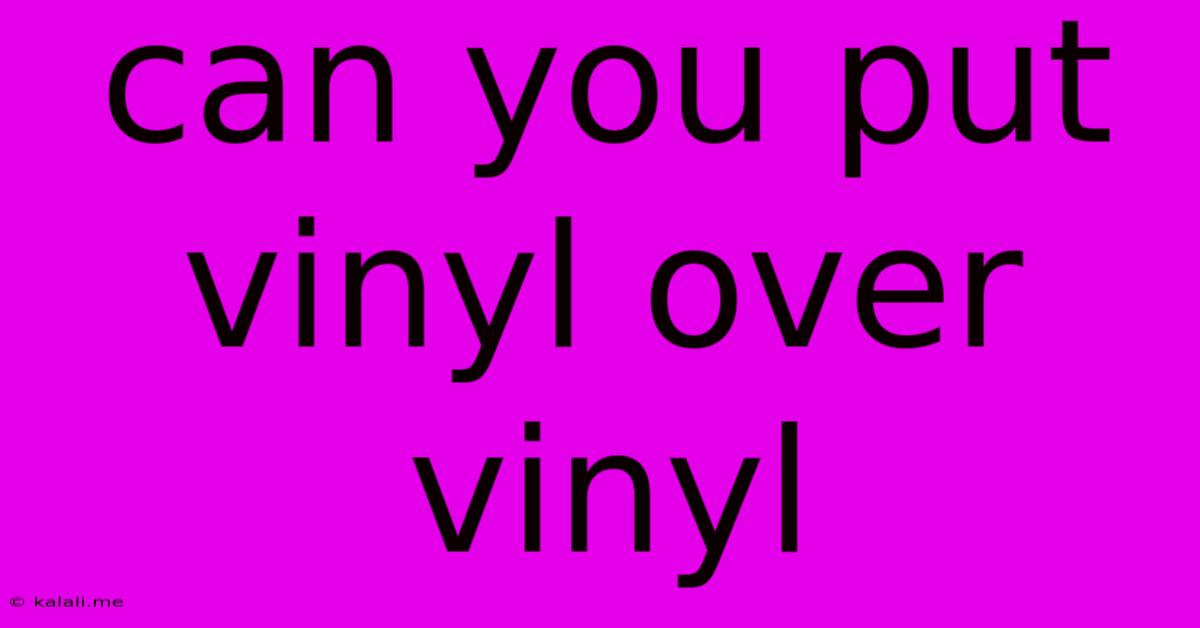Can You Put Vinyl Over Vinyl
Kalali
May 21, 2025 · 4 min read

Table of Contents
Can You Put Vinyl Over Vinyl? A Comprehensive Guide
Meta Description: Wondering if layering vinyl over existing vinyl flooring is a viable option? This guide explores the pros, cons, and crucial considerations before undertaking this DIY project. Learn about surface preparation, suitable vinyl types, and potential pitfalls to avoid costly mistakes.
Layering vinyl over existing vinyl flooring is a tempting DIY project, promising a quick and budget-friendly floor update. However, it’s crucial to understand the complexities before you grab your adhesive. This comprehensive guide explores the feasibility, benefits, drawbacks, and best practices for putting vinyl over vinyl.
Understanding the Challenges of Layering Vinyl
The success of layering vinyl depends heavily on the condition of the existing vinyl and the type of new vinyl you choose. Several factors can significantly impact the final result:
-
Substrate Condition: The existing vinyl must be smooth, clean, and firmly adhered to the subfloor. Any bumps, ripples, or loose sections will show through the new vinyl, creating an uneven and unsightly floor. Extensive damage may require complete removal of the old vinyl.
-
Vinyl Type Compatibility: Not all vinyl types are created equal. Layering sheet vinyl over sheet vinyl is generally more challenging than installing luxury vinyl plank (LVP) or luxury vinyl tile (LVT) over existing vinyl. The thickness and flexibility of the existing vinyl can affect the adhesion and longevity of the new layer. Self-adhesive vinyl is generally not recommended for layering over existing flooring.
-
Subfloor Integrity: The subfloor beneath the existing vinyl is equally important. If the subfloor is uneven, damaged, or suffers from moisture issues, the new vinyl will likely fail prematurely, regardless of the quality of the installation.
When Layering Vinyl is a Good Option
Despite the challenges, layering vinyl over existing vinyl can be a viable solution under specific circumstances:
-
Minor Imperfections: If the existing vinyl is in relatively good condition with only minor imperfections, a new layer of vinyl might successfully mask these flaws.
-
Budget Constraints: Layering vinyl offers a significantly cheaper alternative to complete floor replacement, saving time and labor costs.
-
Quick Renovation: It's a faster process than removing old vinyl and installing new flooring directly onto the subfloor.
-
Suitable Vinyl Choice: Selecting a suitable type of vinyl that is compatible with the existing floor is paramount for successful layering.
When Layering Vinyl is NOT Recommended
In several scenarios, layering vinyl is strongly discouraged:
-
Significant Damage: If the existing vinyl is damaged, loose, or severely uneven, removing it is essential before installing new vinyl to ensure a stable and long-lasting floor.
-
Moisture Issues: If there's any suspicion of moisture damage or problems with the subfloor, addressing these issues before installing new vinyl is crucial to prevent mold growth and structural problems.
-
Incompatible Vinyl Types: Layering certain types of vinyl (e.g., thick sheet vinyl over thin vinyl) can lead to adhesion problems and premature wear and tear.
-
Uneven Subfloor: An uneven subfloor will transfer its imperfections to the new vinyl layer, regardless of how well the new vinyl is installed.
Preparing the Existing Vinyl for Layering
Even if the existing vinyl appears to be in good condition, proper preparation is essential. This involves:
-
Thorough Cleaning: Remove all dirt, debris, and old adhesive residue. Use a suitable cleaner, avoiding harsh chemicals that could damage the existing vinyl.
-
Surface Evaluation: Carefully inspect the existing vinyl for any loose areas, bubbles, or significant damage. Address any issues before proceeding.
-
Priming (If Necessary): In some cases, applying a primer can improve adhesion and prevent problems. Consult the manufacturer's instructions for your chosen vinyl.
Choosing the Right Vinyl for Layering
The choice of vinyl is critical. Luxury vinyl plank (LVP) or luxury vinyl tile (LVT) are often recommended for layering over existing vinyl due to their durability and relative thinness. Sheet vinyl is less ideal due to its thickness and potential for wrinkling or bubbling. Always consult the manufacturer’s guidelines regarding suitability for layering.
Conclusion
Layering vinyl over vinyl can be a successful DIY project, but only under the right conditions. Careful assessment of the existing floor, appropriate preparation, and the selection of compatible vinyl are crucial factors to ensure a long-lasting, attractive, and problem-free result. If you're unsure, it's always best to consult a professional flooring installer.
Latest Posts
Latest Posts
-
How Do You Spell Aunty Or Auntie
May 21, 2025
-
How To Fill In An Esta For A Cruise
May 21, 2025
-
Is The Tap Water In Spain Safe To Drink
May 21, 2025
-
How To Clean Glue Off Tiles
May 21, 2025
-
Can Goldfish Live In A Pond Without A Pump
May 21, 2025
Related Post
Thank you for visiting our website which covers about Can You Put Vinyl Over Vinyl . We hope the information provided has been useful to you. Feel free to contact us if you have any questions or need further assistance. See you next time and don't miss to bookmark.